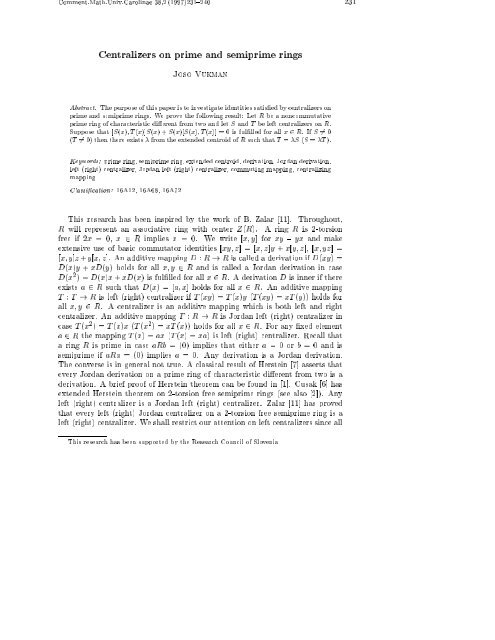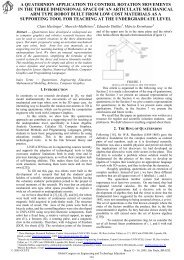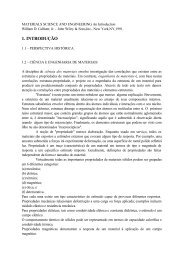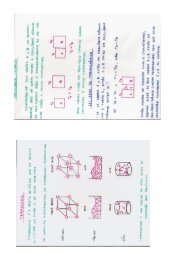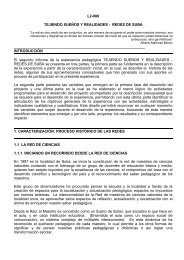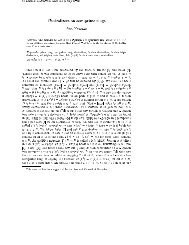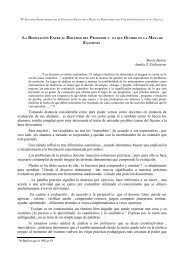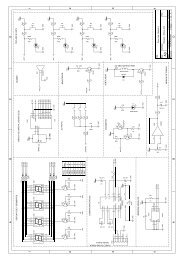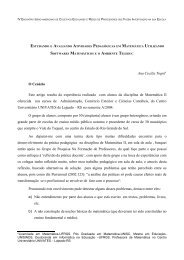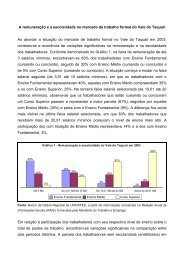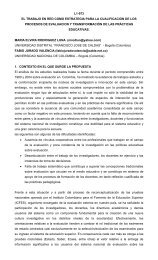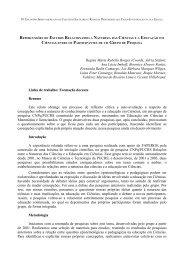Centralizers on prime and semiprime rings
Centralizers on prime and semiprime rings
Centralizers on prime and semiprime rings
You also want an ePaper? Increase the reach of your titles
YUMPU automatically turns print PDFs into web optimized ePapers that Google loves.
Comment.Math.Univ.Carolinae 38,2 (1997)231{240 231<br />
<str<strong>on</strong>g>Centralizers</str<strong>on</strong>g> <strong>on</strong> <strong>prime</strong> <strong>and</strong> semi<strong>prime</strong> <strong>rings</strong><br />
Joso Vukman<br />
Abstract. The purpose of this paper is to investigate identities satised by centralizers <strong>on</strong><br />
<strong>prime</strong> <strong>and</strong> semi<strong>prime</strong> <strong>rings</strong>. We prove the following result: Let R be a n<strong>on</strong>commutative<br />
<strong>prime</strong> ring of characteristic dierent from two <strong>and</strong> let S <strong>and</strong> T be left centralizers <strong>on</strong> R.<br />
Suppose that [S(x);T(x)]S(x)+S(x)[S(x);T(x)] = 0 is fullled for all x 2 R. If S 6= 0<br />
(T 6= 0) then there exists from the extended centroid of R such that T = S (S = T ).<br />
Keywords: <strong>prime</strong> ring, semi<strong>prime</strong> ring, extended centroid, derivati<strong>on</strong>, Jordan derivati<strong>on</strong>,<br />
left (right) centralizer, Jordan left (right) centralizer, commuting mapping, centralizing<br />
mapping<br />
Classicati<strong>on</strong>: 16A12, 16A68, 16A72<br />
This research has been inspired by the work of B. Zalar [11]. Throughout,<br />
R will represent an associative ring with center Z(R). A ring R is 2-torsi<strong>on</strong><br />
free if 2x = 0, x 2 R implies x = 0. We write [x; y] for xy , yx <strong>and</strong> make<br />
extensive use of basic commutator identities [xy; z] =[x; z]y + x[y; z], [x; yz] =<br />
[x; y]z + y[x; z]. An additive mapping D : R ! R is called a derivati<strong>on</strong> if D(xy) =<br />
D(x)y + xD(y) holds for all x; y 2 R <strong>and</strong> is called a Jordan derivati<strong>on</strong> in case<br />
D(x 2 )=D(x)x + xD(x) is fullled for all x 2 R. A derivati<strong>on</strong> D is inner if there<br />
exists a 2 R such that D(x) =[a; x] holds for all x 2 R. An additive mapping<br />
T : T ! R is left (right) centralizer if T (xy) =T (x)y (T (xy) =xT (y)) holds for<br />
all x; y 2 R. A centralizer is an additive mapping which is both left <strong>and</strong> right<br />
centralizer. An additive mapping T : R ! R is Jordan left (right) centralizer in<br />
case T (x 2 )=T (x)x (T (x 2 )=xT (x)) holds for all x 2 R. For any xed element<br />
a 2 R the mapping T (x) =ax (T (x) =xa) is left (right) centralizer. Recall that<br />
a ring R is <strong>prime</strong> in case aRb = (0) implies that either a = 0 or b = 0 <strong>and</strong> is<br />
semi<strong>prime</strong> if aRa = (0) implies a = 0. Any derivati<strong>on</strong> is a Jordan derivati<strong>on</strong>.<br />
The c<strong>on</strong>verse is in general not true. A classical result of Herstein [7] asserts that<br />
every Jordan derivati<strong>on</strong> <strong>on</strong> a <strong>prime</strong> ring of characteristic dierent from two isa<br />
derivati<strong>on</strong>. A brief proof of Herstein theorem can be found in [1]. Cusak [6] has<br />
extended Herstein theorem <strong>on</strong> 2-torsi<strong>on</strong> free semi<strong>prime</strong> <strong>rings</strong> (see also [2]). Any<br />
left (right) centralizer is a Jordan left (right) centralizer. Zalar [11] has proved<br />
that every left (right) Jordan centralizer <strong>on</strong> a 2-torsi<strong>on</strong> free semi<strong>prime</strong> ring is a<br />
left (right) centralizer. We shall restrict our attenti<strong>on</strong> <strong>on</strong> left centralizers since all<br />
This research has been supported by the Research Council of Slovenia
232 J. Vukman<br />
results presented in this paper are true also for right centralizers because of leftright<br />
symmetry. We shall denote by C the extended centroid of a <strong>prime</strong> ring R.<br />
First we list few lemmas.<br />
Lemma 1. Suppose P that the elements a i , b i in the central closure of a <strong>prime</strong><br />
ring R satisfy a i xb i = 0 for all x 2 R. If b i 6= 0 for some i then a i 's are<br />
C-dependent.<br />
The explanati<strong>on</strong> of the noti<strong>on</strong>s of the extended centroid <strong>and</strong> the central closure<br />
of a <strong>prime</strong> ring, as well as the proof of Lemma 1, can be found in [8, pp. 20{23]<br />
or [9].<br />
Lemma 2. Let R be a n<strong>on</strong>commutative <strong>prime</strong> ring <strong>and</strong> let T : R ! R be a left<br />
centralizer. If T (x) 2 Z(R) holds for all x 2 R, then T =0.<br />
Proof: Since [T (x);y] = 0 for all x; y 2 R we have, putting xz for x, 0 =<br />
[T (x)z; y] = [T (x);y]z + T (x)[z; y] = T (x)[z; y]. Thus we have T (x)[z; y] = 0,<br />
which gives T (x)w[z; y] = 0 for all x; y; z; w 2 R whence it follows T = 0, otherwise<br />
R would be commutative.<br />
<br />
Lemma 3. Let R be a n<strong>on</strong>commutative <strong>prime</strong> ring <strong>and</strong> let S : R ! R, T : R ! R<br />
be left centralizers. Suppose that [S(x);T(x)] = 0 holds for all x 2 R. If T 6= 0<br />
then there exists 2 C such that S = T .<br />
Proof: The linearizati<strong>on</strong> (i.e. putting x+y for x) of the relati<strong>on</strong> [S(x);T(x)] = 0<br />
gives<br />
(1) [S(x);T(y)] + [S(y);T(x)] = 0:<br />
Putting in (1) yz for y we obtain 0 = [S(x);T(y)z]+[S(y)z; T(x)] = [S(x);T(y)]z<br />
+T (y)[S(x);z]+[S(y);T(x)]z+S(y)[z; T(x)] = T (y)[S(x);z]+S(y)[z; T(x)]. Thus<br />
we have<br />
T (y)[S(x);z]+S(y)[z; T(x)] = 0:<br />
Putting in the above relati<strong>on</strong> yw for y we obtain<br />
(2) T (y)w[S(x);z]+S(y)w[z; T(x)] = 0:<br />
Since we have assumed that T 6= 0 it follows from Lemma 2 that there exist x; z 2<br />
R such that [T (x);z] 6= 0. Now (2) <strong>and</strong> Lemma 1 imply that S(y) =(y)T (y)<br />
where (y) is from C. Putting in (2) (y)T (y) for S(y) <strong>and</strong> (x)T (x) for S(x)<br />
we obtain ((x) , (y))T (y)w[T (x);z] = 0 for all pairs y; w 2 R whence it follows<br />
((x) , (y))T (y) =0since [T (x);z] 6= 0. Thus we have (x)T (y) =(y)T (y)<br />
which completes the proof of the lemma.<br />
<br />
We are now able to prove the rst theorem of this paper.
<str<strong>on</strong>g>Centralizers</str<strong>on</strong>g> <strong>on</strong> <strong>prime</strong> <strong>and</strong> semi<strong>prime</strong> <strong>rings</strong> 233<br />
Theorem 4. Let R be a n<strong>on</strong>commutative 2-torsi<strong>on</strong> free semi<strong>prime</strong> ring <strong>and</strong><br />
S : R ! R, T : R ! R left centralizers. Suppose that [S(x);T(x)]S(x) +<br />
S(x)[S(x);T(x)] = 0 holds for all x 2 R. In this case we have [S(x);T(x)] = 0 for<br />
all x 2 R. In case R is a <strong>prime</strong> ring <strong>and</strong> S 6= 0(T 6= 0)then there exists 2 C<br />
such that T = S (S = T ).<br />
Proof: We have the relati<strong>on</strong><br />
(3) [S(x);T(x)]S(x)+S(x)[S(x);T(x)] = 0; x 2 R:<br />
Putting in (3) x + y for y we obtain<br />
(4)<br />
[S(x);T(x)]S(y)+S(y)[S(x);T(x)] + [S(x);T(y)]S(x)+S(x)[S(x);T(y)]+<br />
[S(y);T(x)]S(x)+S(x)[S(y);T(x)] + [S(y);T(y)]S(x)+S(x)[S(y);T(y)]+<br />
[S(y);T(x)]S(y)+S(y)[S(y);T(x)]+[S(x);T(y)]S(y)+<br />
S(y)[S(x);T(y)]=0:<br />
Putting in the above relati<strong>on</strong> ,x for x we obtain<br />
(5)<br />
[S(x);T(x)]S(y)+S(y)[S(x);T(x)] + [S(x);T(y)]S(x)+S(x)[S(x);T(y)]+<br />
[S(y);T(x)]S(x)+S(x)[S(y);T(x)] , [S(y);T(y)]S(x) , S(x)[S(y);T(y)],<br />
[S(y);T(x)]S(y) , S(y)[S(y);T(x)] , [S(x);T(y)]S(y),<br />
S(y)[S(x);T(y)]=0:<br />
Combining (4) with (5) we obtain 2[S(x);T(x)]S(y) + 2S(y)[S(x);T(x)] +<br />
2[S(x);T(y)]S(x)+2S(x)[S(x);T(y)]+2[S(y);T(x)]S(x)+2S(x)[S(y);T(x)] = 0<br />
whence it follows<br />
(6)<br />
[S(x);T(x)]S(y)+S(y)[S(x);T(x)] + [S(x);T(y)]S(x)+S(x)[S(x);T(y)]+<br />
[S(y);T(x)]S(x)+S(x)[S(y);T(x)] = 0<br />
since we have assumed that R is 2-torsi<strong>on</strong> free. Putting in the above relati<strong>on</strong> xy<br />
for y we obtain<br />
0=[S(x);T(x)]S(x)y + S(x)y[S(x);T(x)] + [S(x);T(x)y]S(x)+<br />
S(x)[S(x);T(x)y]+[S(x)y; T(x)]S(x)+S(x)[S(x)y; T(x)] =<br />
[S(x);T(x)]S(x)y + S(x)y[S(x);T(x)] + [S(x);T(x)]yS(x)+T (x)[S(x);y]S(x)+<br />
S(x)[S(x);T(x)]y + S(x)T (x)[S(x);y]+[S(x);T(x)]yS(x)+S(x)[y; T(x)]S(x)+<br />
S(x)[S(x);T(x)]y + S(x) 2 [y; T(x)]:<br />
According to (6) the above calculati<strong>on</strong> reduces to<br />
(7)<br />
S(x)y[S(x);T(x)] + 2[S(x);T(x)]yS(x)+T (x)[S(x);y]S(x)+<br />
S(x)T (x)[S(x);y]+S(x)[y; T(x)]S(x)+S(x)[S(x);T(x)]y+<br />
S(x) 2 [y; T(x)]=0:
234 J. Vukman<br />
Putting in the above relati<strong>on</strong> yS(x) for y we obtain<br />
S(x)yS(x)[S(x);T(x)] + 2[S(x);T(x)]yS(x) 2 + T (x)[S(x);y]S(x) 2 +<br />
S(x)T (x)[S(x);y]S(x)+S(x)[y; T(x)]S(x) 2 + S(x)y[S(x);T(x)]S(x)+<br />
S(x)[S(x);T(x)]yS(x)+S(x) 2 [y; T(x)]S(x)+S(x) 2 y[S(x);T(x)] = 0 which leads<br />
according to (7) to<br />
(8) S(x)yS(x)[S(x);T(x)] + S(x) 2 y[S(x);T(x)] = 0:<br />
Putting in (8) T (x)y for y we obtain<br />
(9) S(x)T (x)yS(x)[S(x);T(x)] + S(x) 2 T (x)y[S(x);T(x)] = 0:<br />
Left multiplicati<strong>on</strong> by T (x) gives<br />
(10) T (x)S(x)yS(x)[S(x);T(x)] + T (x)S(x) 2 y[S(x);T(x)] = 0:<br />
From (9) <strong>and</strong> (10) we obtain [S(x);T(x)]yS(x)[S(x);T(x)]+<br />
[S(x) 2 ;T(x)]y[S(x);T(x)] = [S(x);T(x)]yS(x)[S(x);T(x)] + ([S(x);T(x)]S(x) +<br />
S(x)[S(x);T(x)])y[S(x);T(x)] = [S(x);T(x)]yS(x)[S(x);T(x)] = 0. Thus we<br />
have<br />
[S(x);T(x)]yS(x)[S(x);T(x)] = 0:<br />
Left multiplicati<strong>on</strong> of the above relati<strong>on</strong> by S(x) gives<br />
(11) S(x)[S(x);T(x)]yS(x)[S(x);T(x)] = 0<br />
for all pairs x; y 2 R. From (11) it follows<br />
(12) S(x)[S(x);T(x)] = 0:<br />
From (3) <strong>and</strong> (10) we obtain also<br />
(13) [S(x);T(x)]S(x) =0:<br />
From (12) <strong>on</strong>e obtains the relati<strong>on</strong><br />
(14) S(y)[S(x);T(x)] + S(x)[S(y);T(x)] + S(x)[S(x);T(y)] = 0<br />
(see the proof of (6)). Putting in (14) xy for y we obtain<br />
0=S(x)y[S(x);T(x)] + S(x)[S(x)y; T(x)] + S(x)[S(x);T(x)y] =<br />
S(x)y[S(x);T(x)] + S(x)[S(x);T(x)]y + S(x) 2 [y; T(x)] + S(x)[S(x);T(x)]y+<br />
S(x)T (x)[S(x);y]=S(x)y[S(x);T(x)] + S(x) 2 [y; T(x)] + S(x)T (x)[S(x);y]:
<str<strong>on</strong>g>Centralizers</str<strong>on</strong>g> <strong>on</strong> <strong>prime</strong> <strong>and</strong> semi<strong>prime</strong> <strong>rings</strong> 235<br />
Thus we have the relati<strong>on</strong> S(x)y[S(x);T(x)] + S(x) 2 [y; T(x)]+<br />
S(x)T (x)[S(x);y] = 0 which can be written in the form S(x)y[S(x);T(x)] +<br />
S(x) 2 yT(x) , S(x)T (x)yS(x)+S(x)[T (x);S(x)]y = 0 whence it follows<br />
(15) S(x)y[S(x);T(x)] + S(x) 2 yT(x) , S(x)T (x)yS(x) =0<br />
according to (12). Left multiplicati<strong>on</strong> of (15) by T (x) gives<br />
(16) T (x)S(x)y[S(x);T(x)] + T (x)S(x) 2 yT(x) , T (x)S(x)T (x)yS(x) =0:<br />
The substituti<strong>on</strong> T (x)y for y in (15) gives<br />
(17) S(x)T (x)y[S(x);T(x)] + S(x) 2 T (x)yT(x) , S(x)T (x) 2 yS(x) =0:<br />
From (16) <strong>and</strong> (17) <strong>on</strong>e obtains<br />
0=[S(x);T(x)]y[S(x);T(x)] + [S(x) 2 ;T(x)]yT(x)+[T (x);S(x)]T (x)yS(x) =<br />
[S(x);T(x)]y[S(x);T(x)] + ([S(x);T(x)]S(x)+S(x)[S(x);T(x)])yT(x)+<br />
which reduces to<br />
[T (x);S(x)]T (x)yS(x)<br />
(18) [S(x);T(x)]y[S(x);T(x)] + [T (x);S(x)]T (x)yS(x) =0:<br />
The substituti<strong>on</strong> yS(x)z for y in (18) gives<br />
(19) [S(x);T(x)]yS(x)z[S(x);T(x)] + [T (x);S(x)]T (x)yS(x)zS(x) =0:<br />
On the other h<strong>and</strong>, right multiplicati<strong>on</strong> of (18) by zS(x) leads to<br />
(20) [S(x);T(x)]y[S(x);T(x)]zS(x)+[T (x);S(x)]T (x)yS(x)zS(x) =0:<br />
From (19) <strong>and</strong> (20) we obtain<br />
(21) [S(x);T(x)]yA(x; z) =0;<br />
where A(x; z) st<strong>and</strong>s for [S(x);T(x)]zS(x) , S(x)z[S(x);T(x)]. The substituti<strong>on</strong><br />
zS(x)y for y in (21) gives<br />
(22) [S(x);T(x)]zS(x)yA(x; z) =0:<br />
Left multiplicati<strong>on</strong> of (21) by S(x)z leads to<br />
(23) S(x)z[S(x);T(x)]yA(x; z) =0:
236 J. Vukman<br />
Combining (22) with (23) we arrive at<br />
A(x; z)yA(x; z) =0<br />
for all x; y; z 2 R whence it follows A(x; z) =0. In other words<br />
(24) [S(x);T(x)]zS(x) =S(x)z[S(x);T(x)]:<br />
The substituti<strong>on</strong> z = T (x)y in (24) gives<br />
(25) [S(x);T(x)]T (x)yS(x) =S(x)T (x)y[S(x);T(x)]:<br />
The relati<strong>on</strong> (25) makes it possible to replace in (18) [S(x);T(x)]T (x)yS(x) by<br />
S(x)T (x)y[S(x);T(x)]. Thus we have [S(x);T(x)]y[S(x);T(x)],<br />
S(x)T (x)y[S(x);T(x)] = 0, which reduces to<br />
(26) T (x)S(x)y[S(x);T(x)] = 0:<br />
Putting in (26) T (x)y for y we obtain<br />
(27) T (x)S(x)T (x)y[S(x);T(x)] = 0:<br />
Multiplying (26) from the left side by T (x) we obtain<br />
(28) T (x) 2 S(x)y[S(x);T(x)] = 0:<br />
Subtracting (28) from (27) we obtain T (x)[S(x);T(x)]y[S(x);T(x)] = 0 which<br />
gives putting yT(x) for y<br />
for all pairs x; y 2 R whence it follows<br />
T (x)[S(x);T(x)]yT(x)[S(x);T(x)] = 0<br />
(29) T (x)[S(x);T(x)] = 0:<br />
The substituti<strong>on</strong> yT(x) for y in (25) gives because of (29)<br />
(30) [S(x);T(x)]yT(x)S(x) =0:<br />
From (13) we obtain the relati<strong>on</strong><br />
[S(x);T(x)]S(y)+[S(x);T(y)]S(x)+[S(y);T(x)]S(x) =0<br />
(see the proof of (6)). Putting in the above relati<strong>on</strong> xy for y we obtain 0 =<br />
[S(x);T(x)]S(x)y +[S(x);T(x)y]S(x)+[S(x)y; T(x)]S(x) =[S(x);T(x)]yS(x)+<br />
T (x)[S(x);y]S(x)+[S(x);T(x)]yS(x)+S(x)[y; T(x)]S(x). Thus we have
<str<strong>on</strong>g>Centralizers</str<strong>on</strong>g> <strong>on</strong> <strong>prime</strong> <strong>and</strong> semi<strong>prime</strong> <strong>rings</strong> 237<br />
2[S(x);T(x)]yS(x)+T (x)[S(x);y]S(x)+S(x)[y; T(x)]S(x) = 0 which can be written<br />
after some calculati<strong>on</strong> in the form<br />
(31) [S(x);T(x)]yS(x)+S(x)yT(x)S(x) , T (x)yS(x) 2 =0:<br />
The relati<strong>on</strong> (24) makes it possible to replace in (31) [S(x);T(x)]yS(x) by<br />
S(x)y[S(x);T(x)]. Thus we have 0 = S(x)y[S(x);T(x)] + S(x)yT(x)S(x) ,<br />
T (x)yS(x) 2 = S(x)yS(x)T (x) , T (x)yS(x) 2 . We have therefore<br />
(32) S(x)yS(x)T (x) =T (x)yS(x) 2 :<br />
Putting in the above relati<strong>on</strong> T (x)y for y we obtain<br />
(33) S(x)T (x)yS(x)T (x) =T (x) 2 yS(x) 2 :<br />
Left multiplicati<strong>on</strong> of (32) by T (x) leads to<br />
(34) T (x)S(x)yS(x)T (x) =T (x) 2 yS(x) 2 :<br />
Combining (33) with (34) we arrive at<br />
which gives together with (30)<br />
for all pairs x; y 2 R whence it follows<br />
[S(x);T(x)]yS(x)T (x) =0<br />
[S(x);T(x)]y[S(x);T(x)] = 0<br />
(35) [S(x);T(x)]=0:<br />
In case R is a <strong>prime</strong> ring the relati<strong>on</strong> (35) <strong>and</strong> Lemma 3 complete the proof of<br />
the theorem.<br />
<br />
Corollary 5. Let R be a 2-torsi<strong>on</strong> free semi<strong>prime</strong> ring <strong>and</strong> T : R ! R a left<br />
centralizer. Suppose that [T (x);x]x + x[T (x);x]=0holds for all x 2 R. In this<br />
case T is a centralizer.<br />
Proof: Since the assumpti<strong>on</strong>s of Theorem 4 are fullled we have<br />
[T (x);x]=0<br />
for all x 2 R. According to the above relati<strong>on</strong> we have T (x 2 )=T (x)x = xT (x).<br />
Thus we have T (x 2 )=xT (x) for all x 2 R. In other words, T is a Jordan right<br />
centralizer. By Propositi<strong>on</strong> 1.4 in [11] T is a right centralizer which completes the<br />
proof.<br />
<br />
Similarly, putting in Theorem 4 T (x) =x <strong>and</strong> applying again Propositi<strong>on</strong> 1.4<br />
from [11], we obtain the following result.
238 J. Vukman<br />
Corollary 6. Let R be a 2-torsi<strong>on</strong> free semi<strong>prime</strong> ring <strong>and</strong> T : R ! R a left<br />
centralizer. Suppose that [T (x);x]T (x)+T (x)[T (x);x]=0holds for all x 2 R.<br />
In this case T is a centralizer.<br />
The above corollaries characterize centralizers am<strong>on</strong>g all left centralizers <strong>on</strong><br />
2-torsi<strong>on</strong> free semi<strong>prime</strong> <strong>rings</strong>. Both of these results as well as Corollaries 8 <strong>and</strong> 9<br />
at the end of the paper are c<strong>on</strong>tributi<strong>on</strong>s to the theory of so-called commuting<br />
<strong>and</strong> centralizing mappings. A mapping F : R ! R is centralizing <strong>on</strong> a ring R if<br />
[F (x);x] 2 Z(R) for all x 2 R. In a special case when [F (x);x] = 0 for all x 2 R,<br />
a mapping F is called commuting <strong>on</strong> R. The study of centralizing <strong>and</strong> commuting<br />
mappings was initiated by the classical result of Posner [10], which states that<br />
the existence of a n<strong>on</strong>zero centralizing derivati<strong>on</strong> <strong>on</strong> a <strong>prime</strong> ring forces the ring<br />
to be commutative. A lot of work has been d<strong>on</strong>e during the last twenty years in<br />
the eld. The work of Bresar [3], [4], [5], where further references can be found,<br />
should be menti<strong>on</strong>ed.<br />
We are ready for our next result.<br />
Theorem 7. Let R be a 2-torsi<strong>on</strong> free n<strong>on</strong>commutative semi<strong>prime</strong> ring <strong>and</strong> let<br />
S : R ! R, T : R ! R be left centralizers. Suppose that [[S(x);T(x)];S(x)] = 0<br />
is fullled for all x 2 R. In this case we have [S(x);T(x)] = 0 for all x 2 R.<br />
In case R is a <strong>prime</strong> ring <strong>and</strong> S 6= 0(T 6= 0)then there exists 2 C such that<br />
T = S (S = T ).<br />
Proof: The relati<strong>on</strong><br />
(36) [[S(x);T(x)];S(x)] = 0;<br />
gives (see the proof of Theorem 4)<br />
(37) [[S(x);T(x)];S(y)] + [[S(x);T(y)];S(x)] + [[S(y);T(x)];S(x)] = 0:<br />
Putting in (37) xy for y we obtain<br />
0=[[S(x);T(x)];S(x)y]+[[S(x);T(x)y];S(x)] + [[S(x)y; T(x)];S(x)] =<br />
[[S(x);T(x)];S(x)]y + S(x)[[S(x);T(x)];y]+<br />
[[S(x);T(x)]y + T (x)[S(x);y];S(x)] + [[S(x);T(x)]y + S(x)[y; T(x)];S(x)] =<br />
S(x)[[S(x);T(x)];y]+[[S(x);T(x)];S(x)]y +[S(x);T(x)][y; S(x)]+<br />
[T (x);S(x)][S(x);y]+T (x)[[S(x);y];S(x)] + [[S(x);T(x)];S(x)]y+<br />
We have therefore<br />
[S(x);T(x)][y; S(x)] + S(x)[[y; T(x)];S(x)]:<br />
(38)<br />
S(x)[[S(x);T(x)];y]+3[S(x);T(x)][y; S(x)] + T (x)[[S(x);y];S(x)]+<br />
S(x)[[y; T(x)];S(x)] = 0:
<str<strong>on</strong>g>Centralizers</str<strong>on</strong>g> <strong>on</strong> <strong>prime</strong> <strong>and</strong> semi<strong>prime</strong> <strong>rings</strong> 239<br />
Putting in the above relati<strong>on</strong> yS(x) for y we obtain<br />
0=S(x)[[S(x);T(x)];yS(x)] + 3[S(x);T(x)][yS(x);S(x)]+<br />
T (x)[[S(x);yS(x)];S(x)] + S(x)[[yS(x);T(x)];S(x)] =<br />
S(x)[[S(x);T(x)];y]S(x)+S(x)y[[S(x);T(x)];S(x)]+<br />
3[S(x);T(x)][y; S(x)]S(x)+T (x)[[S(x);y]S(x);S(x)]+<br />
S(x)[[y; T(x)]S(x)+y[S(x);T(x)];S(x)] = S(x)[[S(x);T(x)];y]S(x)+<br />
3[S(x);T(x)][y; S(x)]S(x)+T (x)[[S(x);y];S(x)]S(x)+<br />
S(x)[[y; T(x)];S(x)]S(x)+S(x)[y; S(x)][S(x);T(x)] + S(x)y[[S(x);T(x)];S(x)]:<br />
Thus we have according to (36) <strong>and</strong> (38) S(x)[y; S(x)][S(x);T(x)] = 0 which can<br />
be written in the form<br />
(39) S(x)yS(x)[S(x);T(x)] = S(x) 2 y[S(x);T(x)]:<br />
Putting in the above calculati<strong>on</strong> T (x)y for y we obtain<br />
(40) S(x)T (x)yS(x)[S(x);T(x)] = S(x) 2 T (x)y[S(x);T(x)]:<br />
On the other h<strong>and</strong>, left multiplicati<strong>on</strong> of (39) by T (x) gives<br />
(41) T (x)S(x)yS(x)[S(x);T(x)] = T (x)S(x) 2 y[S(x);T(x)]:<br />
Subtracting (41) from (40) we obtain<br />
0=[S(x);T(x)]yS(x)[S(x);T(x)] , [S(x) 2 ;T(x)]y[S(x);T(x)] =<br />
[S(x);T(x)]yS(x)[S(x);T(x)],<br />
([S(x);T(x)]S(x)+S(x)[S(x);T(x)])y[S(x);T(x)]:<br />
According to the requirement of the theorem <strong>on</strong>e can replace in the above calculati<strong>on</strong><br />
[S(x);T(x)]S(x) by S(x)[S(x);T(x)] which gives<br />
[S(x);T(x)]yS(x)[S(x);T(x)] = 2S(x)[S(x);T(x)]y[S(x);T(x)]:<br />
Left multiplicati<strong>on</strong> of the above relati<strong>on</strong> by S(x) gives<br />
(42) S(x)[S(x);T(x)]yS(x)[S(x);T(x)] = 2S(x) 2 [S(x);T(x)]y[S(x);T(x)]:<br />
On the other h<strong>and</strong>, putting [S(x);T(x)]y for y in (39) we arrive at<br />
(43) S(x)[S(x);T(x)]yS(x)[S(x);T(x)] = S(x) 2 [S(x);T(x)]y[S(x);T(x)]:
240 J. Vukman<br />
Combining (42) with (43) we obtain S(x)[S(x);T(x)]yS(x)[S(x);T(x)] = 0 for all<br />
pairs x; y 2 R, whence it follows<br />
(44) S(x)[S(x);T(x)] = 0;<br />
by semi<strong>prime</strong>ness of R. From (44) <strong>and</strong> the assumpti<strong>on</strong> of the theorem we have<br />
also<br />
[S(x);T(x)]S(x) =0:<br />
The rest of the proof goes through in the same way as in the proof of Theorem 4.<br />
<br />
Theorem 7 gives together with Propositi<strong>on</strong> 1.4 from [11] the following characterizati<strong>on</strong>s<br />
of centralizers am<strong>on</strong>g all left centralizers <strong>on</strong> 2-torsi<strong>on</strong> free semi<strong>prime</strong><br />
<strong>rings</strong>.<br />
Corollary 8. Let R be a 2-torsi<strong>on</strong> free semi<strong>prime</strong> ring <strong>and</strong> T : R ! R a left<br />
centralizer. Suppose that [[T (x);x];x]=0holds for all x 2 R. In this case T is a<br />
centralizer.<br />
Corollary 9. Let R be a 2-torsi<strong>on</strong> free semi<strong>prime</strong> ring <strong>and</strong> T : R ! R a left<br />
centralizer. Suppose that [[T (x);x];T(x)] = 0 holds for all x 2 R. In this case T<br />
is a centralizer.<br />
References<br />
[1] Bresar M., Vukman J., Jordan derivati<strong>on</strong>s <strong>on</strong> <strong>prime</strong> <strong>rings</strong>, Bull. Austral. Math. Soc. 37<br />
(1988), 321{323.<br />
[2] Bresar M., Jordan derivati<strong>on</strong>s <strong>on</strong> <strong>prime</strong> <strong>rings</strong>, Proc. Amer. Math. Soc. 104 (1988),<br />
1003{1006.<br />
[3] Bresar M., On a generalizati<strong>on</strong> of the noti<strong>on</strong> of centralizing mappings, Proc. Amer. Math.<br />
Soc. 114 (1992), 641{649.<br />
[4] Bresar M., Centralizing mappings <strong>and</strong> derivati<strong>on</strong>s in <strong>prime</strong> <strong>rings</strong>, Journal of Algebra 156<br />
(1993), 385{394.<br />
[5] Bresar M., Commuting traces of biaditive mappings, commutativity-preserving mappings<br />
<strong>and</strong> Lie mappings, Trans. Amer. Math. Soc. 335 (1993), 525{545.<br />
[6] Cusak J., Jordan derivati<strong>on</strong>s <strong>on</strong> <strong>rings</strong>, Proc. Amer. Math. Soc. 53 (1975), 321{324.<br />
[7] Herstein I.N., Jordan derivati<strong>on</strong>s <strong>on</strong> <strong>prime</strong> <strong>rings</strong>, Proc. Amer. Math. Soc. 8 (1957),<br />
1104{1110.<br />
[8] Herstein I.N., Rings with involuti<strong>on</strong>, Univ. of Chicago Press, Chicago, 1976.<br />
[9] Martindale W.S., Prime <strong>rings</strong> satisfying a generalized polynomial identity, Journal of Algebra<br />
12 (1969), 576{584.<br />
[10] Posner E., Derivati<strong>on</strong>s in <strong>prime</strong> <strong>rings</strong>, Proc. Amer. Math. Soc. 8 (1957), 1093{1100.<br />
[11] Zalar B., On centralizers of semi<strong>prime</strong> <strong>rings</strong>, Comment. Math. Univ. Carolinae 32 (1991),<br />
609{614.<br />
Department of Mathematics, University of Maribor, PEF, Koroska 160,<br />
62000 Maribor, Slovenia<br />
(Received January 23, 1996)


